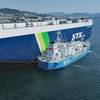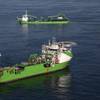The newest buzz among offshore operators serving the oil and gas rigs in the Gulf of Mexico (GOM) is the increased use of methanol (CH3OH) by oil companies and contract drillers. This has meant more work for supply boats carrying this alcohol product to rigs along with rig water, fuel oil and liquid and bulk mud.
Methanol is used to keep the flow lines from the wellhead to the surface of the water from becoming restricted or blocked. Restricted flow from wells is becoming an increasing problem for oil companies and drilling contractors whose bottom line depends on getting every drop of oil from a well. Flow assurance is a critical issue, especially with longer tiebacks in deepwater drilling operations. The problem is that tiebacks and other extended subsea completions tend to cool the oil and gas over the longer distances associated with deepwater wells.
This can cause paraffin wax buildup and the formation of hydrates on the flow lines, restricting the flow of the hydrocarbons to the surface. Paraffin wax is a natural component of oil as it flows from a well and hydrates form when methane (natural gas) mixes with water in the production line forming ice-like crystals. In some cases, the combination of cooled wax coating the flow lines plus the formation of hydrates can complete block the flow lines.
The complete blockage of a flow line is a very serious condition often resulting in the replacement of the flow line in order to resume production. Lines that are not completely blocked can be "pigged", using a mechanical device to remove the line restrictions.
More often, chemical inhibitors such as methanol are used to keep the oil and gas product from freezing in long pipeline runs thereby keeping wax from building up in the lines and preventing the formation of hydrates.
Methanol is a simple alcohol, often known as "wood alcohol." It is often mixed with ethylene glycol and sold as automotive antifreeze. This versatile product is also used as a fuel in competitive auto racing such as Top Fuel Dragsters and "Funny Cars."
Transporting methanol to the jackup rig, semisubmercible rig or tension leg platform is a relatively new function for supply boats. Tanks for drill water, potable water, fuel oil, liquid mud or dry bulk product have been the traditional below deck cargos for supply boats. Now supply boats are being built with dedicated methanol tanks while some existing supply boats are having fuel tanks converted to carry methanol.
"Carrying methanol requires dedicated tanks, pumps and lines," said David Skansi, president of Skansi Marine, New Orleans, La., who currently has a major contract to transport methanol to a platform in the Main Pass. "One of our boats has the capacity to haul 35,000 gallons of methanol in three tanks and we make three to four trips a week to this platform," Skansi added. "It is business we didn't have before we took delivery of this boat," Skansi remarked.
The vessel is the 170-ft. Nick Skansi delivered in 2002 by Boconco Shipbuilding, Bayou La Batre, Ala. The vessel can also transport cargo water, fuel and liquid mud and cargo on her aft deck up to the vessel's deadweight capacity.
The vessel is also equipped with a DP-0 system by EMI, Harahan, La. "DP capability is important when delivering a material such as methanol that can be dangerous to the crew if the boat cannot hold station," Skansi said. DP keeps the vessel in one place while the vessel has the methanol hose hooked to the platform.
Even with a vessel that has good station keeping capabilities, all crew members involved in the transfer of the product from the vessel to the platform must wear rubber boots and gloves, face shields and fire suits to protect themselves from the product in case of an accidental spill. Under certain conditions, methanol can cause damage to the central nervous system if inhaled or if it comes in contact with the skin.
"We also use a hose with a 'dry connection', Skansi said. "When pumping material such as water, fuel oil or liquid mud, no harm is caused if some of the material leaks out when the connection is broken," Skansi added. "We can't take that chance with methanol, so we use a dry connection type of hose so no material escapes," Skansi remarked.
Handling of methanol inside the OSV also requires special care. The U.S. Coast Guard Marine Safety Manual outlines the precautions that must be followed when methanol is carried onboard an OSV.
Methanol tanks are to be installed in a cofferdam to prevent leakage. Often this cofferdam is a water or fuel oil tank fitted over the methanol tank. Piping and manifolds are usually stainless steel and double piping is used in passageways or other areas where the crew is present. Methanol pumps must be explosion proof and so must be devices such as light fixtures that are within 10 ft. of the pump.
"These precautions just make sense and once you have the equipment and personnel training in place, methanol is can be safely delivered to a rig or platform," Skansi added.
Supply vessel operators such as Barry Graham Oil Services, Bayou La Batre, Ala. are also adding methanol carrying capacity to their new build programs. Graham is building six 126-ft. utility vessels and one 145-ft. vessel. All seven vessels will have methanol carrying capability. The smaller vessels will haul 14,309 gallons of methanol in a single tank The 145-ft. vessel will carry 40,000 gallons of methanol in four tanks and 38,000 gallons of fuel oil. Boconco Shipbuilding, also of Bayou La Batre, is building the seven vessels.
Larger offshore operators such as Edison Chouest Offshore, Galliano, La. are recognizing the potential of transporting methanol. Chouest is having three 145-ft. by 36-ft. supply boats built by Bollinger primarily haul liquid mud and methanol.
The boats are being called "Production Completion" vessels to emphasize their role in carrying liquid mud and methanol. Each of the three vessels will have four liquid mud tanks and two methanol tanks. The aft deck measures 95 ft. by 32 ft. and can carry 390 long tons of cargo. One vessel was delivered earlier this year while the other two vessels have delivery dates of October and December 2002.
The methanol tanks of the Chouest vessels and other methanol carrying vessels being built by Bollinger use an interior tank coating of inorganic zinc silicate manufactured by International Paint, Inc. called Interzinc 344. Tom Bayard, of International Paint, noted that the "aggressive characteristics" of methanol call for an extra tough coating. "An epoxy system won't do," Bayard said. "Methanol will soften the entire interior tank coating system causing the vessel operator to vent the tanks for 2-3 days after emptying so the epoxy can cure again," Bayard said.
International Paint's recommendations call for surface preparation by blasting the interior steel of the tank or tanks to near white metal and applying a full coat of Interzinc 344. Next all welds, angles and sharp edges are given a stripe coat so that the entire interior of the tank has a 3-5 mil coating. Methanol will not attack the interior of the tank if the surface preparation and coating steps are followed.
Other Bollinger 145's equipped to carry methanol include the Lytal Ashley and Lytal Andre owned by Lytal Marine, Lockport, La. The series of 145's owned by Seahorse Marine (now a part of Seacor Marine) also have methanol carrying capabilities.
Bollinger Shipyards feels that the carrying of methanol opens new markets and opportunities for supply boat operators. "We have put methanol carrying capability on several of our 145's and have gotten serious inquiries about adding it to our larger OSVs," said Robert Socha, marketing manager of Bollinger. "We hear that Shell is adding methanol to all of their TLPs (Tension Leg Platforms,)" Socha added.
"In this business, the oil companies that call the shots…so if majors such as Shell want methanol, then supply vessel operators will find a way to satisfy that demand and as supply boat builders we will engineer and build vessels that can carry methanol safely and efficiently," Socha said.
Socha also said that a major GOM operator has a supply vessel in one of its repair yards being stretched with a midbody plug just to add methanol carrying capacity. No doubt other offshore operators are looking seriously at converting existing water or fuel oil tanks to methanol or adding them during the construction process to new vessels.
Sponsored Content
Chris-Marine’s solutions help to prolong engine lifetime

Subscribe for
Maritime Reporter E-News
Maritime Reporter E-News is the maritime industry's largest circulation and most authoritative ENews Service, delivered to your Email five times per week










